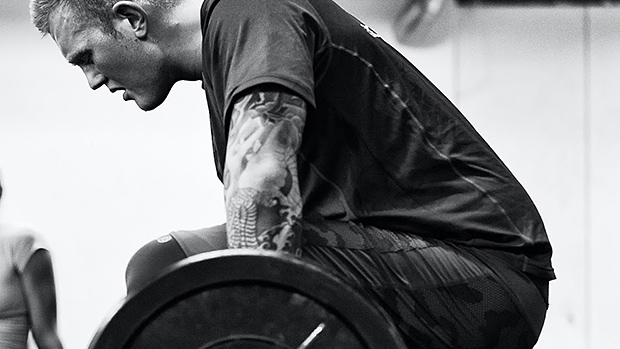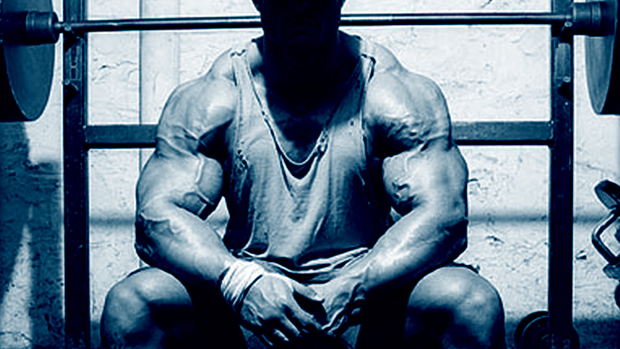The act of grabbing an overhead bar and pulling yourself up until your chin clears that bar is pretty difficult for most people.
In fact, some individuals would consider it impossible, but like anything else, where there's a will, there's a way and chin-ups are no different.
With the proper training and a few key elements in place, achieving 20 chin-ups is a real possibility.
Let's start by looking at the top 3 variables required to get past this (high) hurdle:
1. Body Weight
Body weight (BW) is the top factor. The more you weigh, the more difficult it is to lift your weight. You're likely to be more successful with chin-ups if you weigh closer to 100 pounds than if you weigh closer to 300 pounds. It just makes sense.
Does strength come in to play? Absolutely, but that's the third factor – it's not number one for the simple reason that an extremely strong individual will struggle with chin-ups if he's heavy.
Don't believe me? Ask any 250 pound-plus bodybuilder or powerlifter to perform as many chin-ups as possible – and I'm talking about strict, controlled, dead-hang-to-chin-clearing chin-ups – and you'll be able to count the reps on one hand, maybe two if they're lucky, but no more than that.
2. Body Composition
Body composition comes next. Obviously, the higher the muscle mass and the lower the body fat, the better! If you have two individuals with the same BW, the leaner one will always win out. When it comes to chin-ups and pretty much any other BW exercise, fat is non-functional tissue Ð it won't contribute to your performance and will simply weigh you down.
When advanced trainees embark on a body composition phase, the goal is to maintain muscle mass and strength while decreasing body fat. Often, a few pounds of BW are lost in the process and the end result with regards to chin-ups is that the absolute numbers may drop slightly (i.e., instead of a 1RM with an additional 100 pounds attached to a chin/dip belt, it drops to 90 pounds), but the relative numbers always increase. Basically, you'll be able to do more BW chin-ups.
3. Strength
Strength is the next factor. Building strength in your arms, shoulders and back will help your efforts. A strong grip is also an asset when it comes to chin-ups. If you can barely do 1 or 2 chin-ups, though, the initial goal should be to improve relative strength, or the ability to produce maximum force relative to your BW.
The loading parameters required to improve this form of strength are as follows:
- High intensity (85-100% 1RM)
- Low reps (1-5)
- High sets (5+)
- Explosive concentric actions (i.e., with high loads the actual velocity may be slow, but the intent should always be fast)
- Longer rest intervals (3-5 minutes)
- Sufficient rest and recovery between training sessions (4+ days)
Let's look at some specific methods to improve your ability to perform a chin-up. First a quick review: isometric strength is 10-15% greater than concentric strength, and eccentric strength can be as much as 40% greater than isometric strength. (A great paper on this topic is "Strength Training: Structure, Principles, and Methodology" by Dr. Dietmar Schmidtbleicher.)
If you're unable to raise your body from a dead hang in the bottom position of a chin-up until your chin clears the bar at the top position (i.e., the concentric action), then focus on the stronger isometric (static) and eccentric (lowering) actions. Here's how to do it...
For eccentric training, perform partner- or band-assisted chin-ups (where your partner holds onto your legs or you hook both feet into a band that's attached to the overhead bar) and emphasize a slow, controlled lowering (typically 4-5 seconds to lower).
On the last repetition of each set, take 10 seconds to lower in a controlled fashion from top to bottom. As you get stronger over time, reduce the amount of assistance until you're able to perform the movement on your own. You can reduce the partner or band assistance by going from two legs to one leg and/or by using a smaller band (wider bands provide greater assistance).
For isometric training, perform partial range movements and insert static holds between the eccentric to concentric transition phase. Start from the top -Ð either use a bench or chair to get to the initial position or simply jump up – and lower down a quarter of the way, which equates to 45 degrees of elbow extension.
Pause for 1-2 seconds and then go back up. On the last rep, hold the static contraction for 10 seconds (at least, "try" to hold it for 10 seconds!). There is a +/- 15-degree carryover in strength when you perform isometrics in this manner.
Over time, increase the range of motion (ROM). Go from 1/4 chin-ups (45 degrees of elbow extension) to 1/2 chin-ups (90 degrees of elbow extension), to 3/4 chin-ups (135 degrees of elbow extension), to full ROM chin-ups where the arms are completely straight (180 degrees) in the bottom position.
Once you've acquired a sufficient amount of strength to clear the chin-up bar a few times, you must shift your focus toward muscular endurance to be able to perform more repetitions. I present a number of these methods in my book, The Elite Trainer, but here's a classic one. Let's say you can easily knock out 10 consecutive reps without any rest. Cut that number in half and do 4 sets of 5 reps with 3 minutes of rest in between. This should be very manageable for most people, but if not, try 5 sets of 4 reps instead and/or increase the rest interval to 4 minutes or even 5 minutes if necessary.
Each session, shave 5-10 seconds (or less if you find it extremely challenging) from the rest interval until there's no longer any rest between sets and you're capable of performing 20 consecutive reps without stopping once.
You've got to be very accurate with your rest intervals, though. Use a stopwatch if you can and start the count as soon as your feet touch the floor. When you get within 10 seconds, stop the timer, reset it to zero, get in position, and go.
By the way, if you plan to get your 20 reps using a machine, plan again! Using a machine that will deload and stabilize the body in any manner will significantly reduce the activity of the small stabilizer muscles that help assist the larger prime movers, and the contribution of core muscles will be greatly reduced as well.
So in simple terms, the prime movers get strong but not the stabilizers. Then, when your body is no longer resting against a movable knee/foot platform (e.g., Gravitron), slant board (e.g., Total Gym), or seat (e.g., lat pulldown), the stabilizers cannot "stabilize" effectively Ð they just do not have the strength since they've been rather dormant throughout the training process, and they shut down the prime movers.
Going from a machine-based chin-up or pulldown to a "machineless" chin-up done from a simple overhead bar is a reality check and a real eye-opener for many people. Practice the real thing and don't kid yourself!

The Trump Factor...
There is one more factor to consider, and this one may trump them all, especially when it comes to females: it's perception! If you perceive that you cannot perform a chin-up (let alone 20), then you won't! It's a self-fulfilling prophecy. The mind plays a huge role. You must believe that you can do it first in order to succeed.
Many people limit themselves before they even grab the bar. For instance, if you constantly max out at 12 reps, your brain expects you to fatigue at that point. It's going to be tough to do another 8 reps, but there is a way. You need to trick your brain.
Here's a tip I learned from Karsten Jensen, a former strength and conditioning coach for the Danish National Elite Sports Institution in Copenhagen, Denmark. Start counting reps at number 10 instead of 1. By the time you hit a count of 20, you've performed a manageable 10 reps.
Next workout, start the count at 9, the following workout at 8, and so on. According to Jensen, part of the reason why you fail to achieve 20 reps is because you expect to get tired by the 12th rep, but altering the count and creating the experience of achieving 20 reps will help break the plateau.
So to sum it up: get lean, get strong, build up the right muscles, practice often and play with your rep count, and one day you'll hit that 20 mark. And if you get to a point where you can do more than 20 chin-ups, gain weight!





